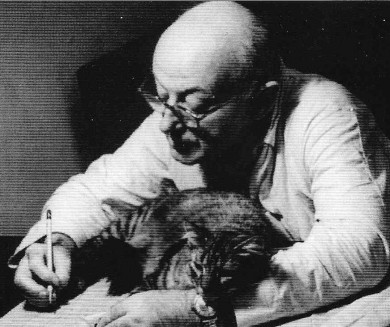New World Percussion Consort offers bracing Cowell and a world premiere

Three works of Henry Cowell were performed by the New World Percussion Consort Saturday night.
The New World Symphony Percussion Consort presented a cornucopia of diverse scores at the New World Center in Miami Beach. A world premiere, pioneering works by one of the first composers to write for percussion ensemble and a score by an electronic music specialist comprised the stimulating bill of fare Saturday night.
Paul Lansky, who has taught at Princeton University for over four decades, has specialized in electronic and computer-generated music. Returning to acoustic music in recent years, he devised the ten-movement suite Threads for the New York-based quartet So Percussion in 2005. In a prerecorded video commentary, the composer explained that he conceived the score in the form of a Bach cantata with attendant preludes, choruses, recitatives and arias. Lasting thirty minutes, the piece seemed much shorter, so inventive and engaging were Lansky’s interplay of textures and timbres.
The preludes and arias are lyrically conceived with pitched vibraphone, glockenspiel and pipes adding color and overlapping melodies. Hard, aggressive drumming consumes the choruses while delightful boundary-pushing interludes for such non-traditional instruments as bottles and flower pots form the recitatives. From the opening minimalist figure to the final Choral Prelude, which simulates the noble serenity of Bach, Lansky’s score is a lively, constantly surprising display of percussive effects, both coolly sonorous and wildly raucous. Brian Flescher, Robert Klieger, Robert Knopper and Erick Wood were a brilliantly rhythmic foursome, vividly projecting the composer’s interweaving of melody and edgy power.
Henry Cowell (1897-1965) was one of music’s true innovators. An early advocate of atonality and chance music, Cowell was one of the first composers to create an all-percussion score.
His Ostinato Pianissimo (1934) for six percussionists and four hand “string piano” (played with hands on the strings) still sounds blazingly original today. A series of overlapping layers punctuate the repetitive ostinato, the score conceived solely in terms of rhythm and texture. The composer’s Asian musical influences are strongly felt, both in instrumentation (woodblocks and gongs) and the remarkably quiet aura. A brilliant xylophone solo suggests jazzy improvisation. Almost eight decades after its creation, Ostinato Pianissimo remains a milestone in the percussion repertoire. Michael Linville and Marnie Hauschildt brought color and dexterity to the unusual keyboard requirements.
Cowell’s Return (1939) is a mournful lament that concludes with a wailer sounding a siren. By contrast Pulse (1939) is a study in relentless rhythmic figurations. The ensemble’s performances under Linville’s firm direction generated visceral power and impact.
The premiere of Radiant Child by David T. Little, a New World Symphony commission, proved a mini-concerto for percussion quartet and chamber orchestra. A well-constructed lightweight essay, the score purports to convey the joy, fear and seriousness surrounding parenthood. Glockenspiel and marimba dominate the excited opening movement “Ecstatic Music.” The opening string figure suggests neo-Baroque roots but the music threatens to morph into a John Williams film score before the pitched metallic instruments reclaim the proceedings in a repetitive minimalist riff.
A pensive second movement seemed the work’s strongest segment. Here the quartet offers brief overlapping thematic threads over extendd chords in the orchestra. A brass fanfare that introduces the finale becomes the kernel of the principal percussion theme, followed by a more sinewy figure. The piano adds a fifth percussive voice, broadening the textural palette while three sighing violins presage the piece’s soft conclusion.
Little’s work doesn’t possess the imagination and creative daring of the Lansky and Cowell scores heard earlier in the program yet it proved a surefire crowd pleaser. Linville’s irrepressible enthusiasm for the score propelled his vital conducting, the players in top form. Sergio Carreno, Klieger, Knopper and Wood were the stellar quartet, all joining at the marimbas in the finale.
Posted in Performances
Leave a Comment
Tue Apr 26, 2011
at 10:37 am
No Comments






